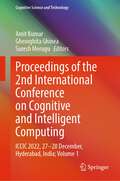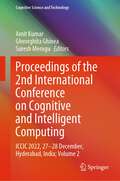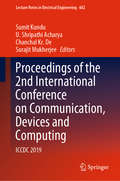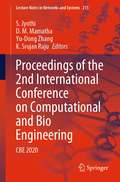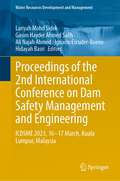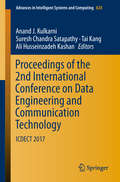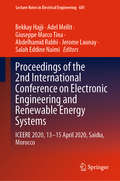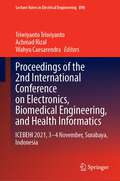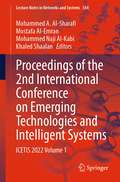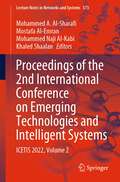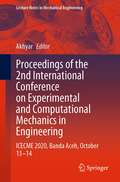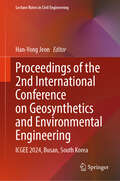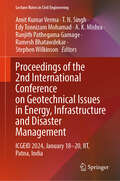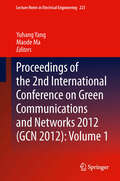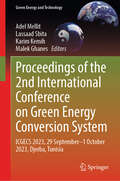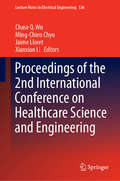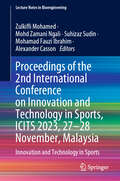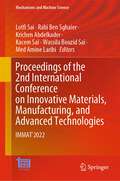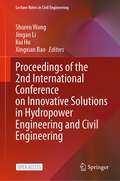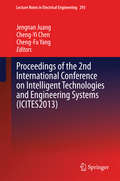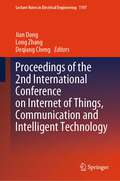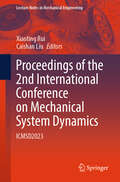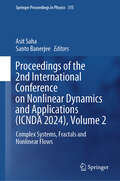- Table View
- List View
Proceedings of the 2nd International Conference on Cognitive and Intelligent Computing: ICCIC 2022, 27–28 December, Hyderabad, India; Volume 1 (Cognitive Science and Technology)
by Amit Kumar Suresh Merugu Gheorghita GhineaThis book includes original, peer-reviewed articles from the 2nd International Conference on Cognitive & Intelligent Computing (ICCIC-2022), held at Vasavi College of Engineering Hyderabad, India. It covers the latest trends and developments in areas of cognitive computing, intelligent computing, machine learning, smart cities, IoT, artificial intelligence, cyber-physical systems, cybernetics, data science, neural network, and cognition. This book addresses the comprehensive nature of computational intelligence, cognitive computing, AI, ML, and DL to emphasize its character in modeling, identification, optimization, prediction, forecasting, and control of future intelligent systems. Submissions are original, unpublished, and present in-depth fundamental research contributions either from a methodological/application perspective in understanding artificial intelligence and machine learning approaches and their capabilities in solving diverse range of problems in industries and its real-world applications.
Proceedings of the 2nd International Conference on Cognitive and Intelligent Computing: ICCIC 2022, 27–28 December, Hyderabad, India; Volume 2 (Cognitive Science and Technology)
by Amit Kumar Suresh Merugu Gheorghita GhineaThis book includes original, peer-reviewed articles from the 2nd International Conference on Cognitive & Intelligent Computing (ICCIC-2022), held at Vasavi College of Engineering Hyderabad, India. It covers the latest trends and developments in areas of cognitive computing, intelligent computing, machine learning, smart cities, IoT, artificial intelligence, cyber-physical systems, cybernetics, data science, neural network, and cognition. This book addresses the comprehensive nature of computational intelligence, cognitive computing, AI, ML, and DL to emphasize its character in modeling, identification, optimization, prediction, forecasting, and control of future intelligent systems. Submissions are original, unpublished, and present in-depth fundamental research contributions either from a methodological/application perspective in understanding artificial intelligence and machine learning approaches and their capabilities in solving diverse range of problems in industries and its real-world applications.
Proceedings of the 2nd International Conference on Communication, Devices and Computing: ICCDC 2019 (Lecture Notes in Electrical Engineering #602)
by Sumit Kundu Surajit Mukherjee U. Shripathi Acharya Chanchal Kr. DeThis book gathers high-quality papers presented at the 2nd International Conference on Communication, Devices & Computing (ICCDC 2019), held at Haldia Institute of Technology from March 14–15, 2019. The papers are divided into three main areas: communication technologies, electronics circuits & devices and computing. Written by students and researchers from around the world, they accurately reflect the global status quo.
Proceedings of the 2nd International Conference on Computational and Bio Engineering: CBE 2020 (Lecture Notes in Networks and Systems #215)
by K. Srujan Raju Yu-Dong Zhang S. Jyothi D. M. MamathaThis book presents the peer-reviewed proceedings of the 2nd International Conference on Computational and Bioengineering (CBE 2020) jointly organized in virtual mode by the Department of Computer Science and the Department of BioScience & Sericulture, Sri Padmavati Mahila Visvavidyalayam (Women's University), Tirupati, Andhra Pradesh, India, during 4–5 December 2020. The book includes the latest research on advanced computational methodologies such as artificial intelligence, data mining and data warehousing, cloud computing, computational intelligence, soft computing, image processing, Internet of things, cognitive computing, wireless networks, social networks, big data analytics, machine learning, network security, computer networks and communications, bioinformatics, biocomputing/biometrics, computational biology, biomaterials, bioengineering, and medical and biomedical informatics.
Proceedings of the 2nd International Conference on Dam Safety Management and Engineering: ICDSME 2023, 16—17 March, Kuala Lumpur, Malaysia (Water Resources Development and Management)
by Lariyah Mohd Sidek Gasim Hayder Ahmed Salih Ali Najah Ahmed Ignacio Escuder-Bueno Hidayah BasriThis book presents peer-reviewed articles from the 2nd International Conference on Dam Safety Management and Engineering (ICDSME 2023), organized by the Malaysian National Committee on Large Dams (MYCOLD), Tenaga Nasional Berhad (TNB), Department of Irrigation and Drainage (DID) and Universiti Tenaga Nasional (UNITEN). With the theme “resilient dams for resilient communities,” the conference highlights dam safety and engineering issues by together dam professionals and experts around the world to discuss, reflect and share their experiences in addressing these issues.
Proceedings of the 2nd International Conference on Data Engineering and Communication Technology: ICDECT 2017 (Advances in Intelligent Systems and Computing #828)
by Suresh Chandra Satapathy Anand J. Kulkarni Tai Kang Ali Husseinzadeh KashanThis book features research work presented at the 2nd International Conference on Data Engineering and Communication Technology (ICDECT) held on December 15–16, 2017 at Symbiosis International University, Pune, Maharashtra, India. It discusses advanced, multi-disciplinary research into smart computing, information systems and electronic systems, focusing on innovation paradigms in system knowledge, intelligence and sustainability that can be applied to provide feasible solutions to varied problems in society, the environment and industry. It also addresses the deployment of emerging computational and knowledge transfer approaches, optimizing solutions in a variety of disciplines of computer science and electronics engineering.
Proceedings of the 2nd International Conference on Electronic Engineering and Renewable Energy Systems: ICEERE 2020, 13-15 April 2020, Saidia, Morocco (Lecture Notes in Electrical Engineering #681)
by Bekkay Hajji Giuseppe Marco Tina Abdelhamid Rabhi Adel Mellit Jerome Launay Salah Eddine NaimiThis book includes papers presented at the Second International Conference on Electronic Engineering and Renewable Energy (ICEERE 2020), which focus on the application of artificial intelligence techniques, emerging technology and the Internet of things in electrical and renewable energy systems, including hybrid systems, micro-grids, networking, smart health applications, smart grid, mechatronics and electric vehicles. It particularly focuses on new renewable energy technologies for agricultural and rural areas to promote the development of the Euro-Mediterranean region. Given its scope, the book is of interest to graduate students, researchers and practicing engineers working in the fields of electronic engineering and renewable energy.
Proceedings of the 2nd International Conference on Electronics, Biomedical Engineering, and Health Informatics: ICEBEHI 2021, 3–4 November, Surabaya, Indonesia (Lecture Notes in Electrical Engineering #898)
by Achmad Rizal Wahyu Caesarendra Triwiyanto TriwiyantoThis book presents high-quality peer-reviewed papers from the International Conference on Electronics, Biomedical Engineering, and Health Informatics (ICEBEHI) 2021 held at Surabaya, Indonesia, virtually. The contents are broadly divided into three parts: (i) electronics, (ii) biomedical engineering, and (iii) health informatics. The major focus is on emerging technologies and their applications in the domain of biomedical engineering. It includes papers based on original theoretical, practical, and experimental simulations, development, applications, measurements, and testing. Featuring the latest advances in the field of biomedical engineering applications, this book serves as a definitive reference resource for researchers, professors, and practitioners interested in exploring advanced techniques in the field of electronics, biomedical engineering, and health informatics. The applications and solutions discussed here provide excellent reference material for future product development.
Proceedings of the 2nd International Conference on Emerging Technologies and Intelligent Systems: ICETIS 2022 Volume 1 (Lecture Notes in Networks and Systems #584)
by Khaled Shaalan Mostafa Al-Emran Mohammed A. Al-Sharafi Mohammed Naji Al-KabiThis book sheds light on the recent research directions in intelligent systems and their applications. It involves two main themes, including management information systems and advances in information security and networking. The discussion of the most recent designs, advancements, and modifications of intelligent systems, as well as their applications, is a key component of the chapters contributed to the aforementioned subjects.
Proceedings of the 2nd International Conference on Emerging Technologies and Intelligent Systems: ICETIS 2022, Volume 2 (Lecture Notes in Networks and Systems #573)
by Khaled Shaalan Mostafa Al-Emran Mohammed A. Al-Sharafi Mohammed Naji Al-KabiThis book sheds light on the recent research directions in intelligent systems and their applications. It involves four main themes: artificial intelligence and data science, recent trends in software engineering, emerging technologies in education, and intelligent health informatics. The discussion of the most recent designs, advancements, and modifications of intelligent systems, as well as their applications, is a key component of the chapters contributed to the aforementioned subjects.
Proceedings of the 2nd International Conference on Experimental and Computational Mechanics in Engineering: ICECME 2020, Banda Aceh, October 13–14 (Lecture Notes in Mechanical Engineering)
by AkhyarThis book gathers a selection of peer-reviewed papers presented at the 2nd International Conference on Experimental and Computational Mechanics in Engineering (ICECME 2020), held as a virtual conference and organized by Universitas Syiah Kuala, Banda Aceh, Indonesia, on 13–14 October 2020. The contributions, prepared by international scientists and engineers, cover the latest advances in computational mechanics, metallurgy and material science, energy systems, manufacturing processing systems, industrial and system engineering, biomechanics, artificial intelligence, micro/nano-engineering, micro-electro-mechanical system, machine learning, mechatronics, and engineering design. The book is intended for academics, including graduate students and researchers, as well as industrial practitioners working in the areas of experimental and computational mechanics.
Proceedings of the 2nd International Conference on Geosynthetics and Environmental Engineering: ICGEE 2024, Busan, South Korea (Lecture Notes in Civil Engineering #396)
by Han-Yong JeonThis book presents selected papers from the 2nd Proceedings of the International Conference on Geosynthetics and Environmental Engineering, ICGEE 2024, held in Busan, South Korea, covering topic areas in geosynthetic applications and sustainability; civil and structural engineering; and environmental engineering and science. The published articles cover the latest research studies with the focus of discussing the relationship between geotechnical materials and environmental engineering in depth to solve complex geosynthetics issues in civil and environmental engineering. It also highlights state-of-the-art technologies adopted by the relevant industries which are not only commercially viable but also environmentally sustainable. The content of the papers appeals to researchers and industrial practitioners working in the field of geoengineering.
Proceedings of the 2nd International Conference on Geotechnical Issues in Energy, Infrastructure and Disaster Management: ICGEID 2024, January 18–20, IIT, Patna, India (Lecture Notes in Civil Engineering #475)
by Stephen Wilkinson T. N. Singh Amit Kumar Verma Edy Tonnizam Mohamad A. K. Mishra Ranjith Pathegama Gamage Ramesh BhatawdekarThis book consists of selected papers presented at the 2nd International Conference on Geotechnical Issues in Energy, Infrastructure and Disaster Management (ICGEID 2024), held on January 19-20, 2024 at IIT, Patna, India. The papers represent the research work in the related fields of underground mining, ground control, mining geotechnics, geo-instrumentation, mine tunneling, and underground structures. It focuses on the latest technology being implemented including artificial intelligence and machine learning applications to solve challenges in mining tunneling and geotechnical structure engineering. It also highlights the state-of-the-art technologies adopted by the civil and mining industry for their commercial as well as environmental benefits. The papers are presented by an international pool of academics, research scientists, and industrial experts and therefore cater to the global audience from the field of underground engineering.
Proceedings of the 2nd International Conference on Green Communications and Networks 2012: Volume 3 (GCN #2012)
by Maode Ma Yuhang YangThe objective of the 2nd International Conference on Green Communications and Networks 2012 (GCN 2012) is to facilitate an exchange of information on best practices for the latest research advances in the area of communications, networks and intelligence applications. These mainly involve computer science and engineering, informatics, communications and control, electrical engineering, information computing, and business intelligence and management. Proceedings of the 2nd International Conference on Green Communications and Networks 2012 (GCN 2012) will focus on green information technology and applications, which will provide in-depth insights for engineers and scientists in academia, industry, and government. The book addresses the most innovative research developments including technical challenges, social and economic issues, and presents and discusses the authors' ideas, experiences, findings, and current projects on all aspects of advanced green information technology and applications. Yuhang Yang is a professor at the Department of Electronic Engineering, Shanghai Jiao Tong University. Maode Ma is an associate professor at the School of Electrical & Electronic Engineering, Nanyang Technological University.
Proceedings of the 2nd International Conference on Green Energy Conversion System: ICGECS 2023, 29 September–1 October 2023, Djerba, Tunisia (Green Energy and Technology)
by Adel Mellit Lassaad Sbita Karim Kemih Malek GhanesThis book presents peer reviewed articles from the 2nd International Conference on Green Energy Conversion Systems held in Djerba, Tunisia, from 13–15 September 2023. It brings together researchers and professionals from all over the world to share and discuss recent advancements and developments in renewable energy and its applications and foster future collaboration tending towards zero carbon.
Proceedings of the 2nd International Conference on Healthcare Science and Engineering (Lecture Notes in Electrical Engineering #536)
by Jaime Lloret Chase Q. Wu Xianxian Li Ming-Chien ChyuThis book presents a compilation of selected papers from the 2nd International Conference on Healthcare Science and Engineering (Healthcare 2018). The work focuses on novel computing, networking, and data analytics techniques for various issues in healthcare. The book is a valuable resource for academic researchers and practitioners working in the field.
Proceedings of the 2nd International Conference on Innovation and Technology in Sports, ICITS 2023, 27–28 November, Malaysia: Innovation and Technology in Sports (Lecture Notes in Bioengineering)
by Alexander Casson Zulkifli Mohamed Mohd Zamani Ngali Suhizaz Sudin Mohamad Fauzi IbrahimThis book compiles the proceedings of ICITS 2023 that comprehensively includes diverse technological facets within the realm of Sports Engineering and Technology. The book encompasses various specialized tracks, including instrumentation, materials, data analytics, biomechanics, simulation, equipment design, and performance analysis, among others. A deeper understanding of the pivotal challenges encountered and technological breakthroughs achieved in the pursuit of enhancing sporting performance is deliberated. The readers are expected to gain insights into prevailing trends, pertinent issues, ameliorative factors, cutting-edge technological innovations, and proposed remedies, thereby further enriching their knowledge of this multidisciplinary field.
Proceedings of the 2nd International Conference on Innovative Materials, Manufacturing, and Advanced Technologies: IMMAT'2022 (Mechanisms and Machine Science #144)
by Med Amine Laribi Lotfi Sai Rabï Ben Sghaier Krichen Abdelkader Kacem Saï Wassila Bouzid SaïThis book presents select proceedings of the 2nd International Conference on Innovative Materials, Manufacturing and Advanced Technologies (IMMAT'2022), held in Sousse, Tunisia, on October 27-29, 2022. The covered topics include theoretical, experimental and technological works and its application in various challenging domains like materials sciences, mechanical design, manufacturing, environment and heat transfer. The volume provides an overview of innovations and technological advances in mechanical engineering. Given the selected and peer reviewed papers, it will be a useful resource for practitioners working on cutting-edge topics in several areas related to the mechanics such as mechanical behavior, material-process interaction, fatigue behavior, tribological behavior of surfaces, manufacturing, organization and optimization of production processes, additive manufacturing processes, renewable energy, design of lightweight components, robotics and industry 4.0. This book is intended to serve researchers, engineers and professionals working in the fields of material and mechanical engineering.
Proceedings of the 2nd International Conference on Innovative Solutions in Hydropower Engineering and Civil Engineering (Lecture Notes in Civil Engineering #235)
by Shuren Wang Jingan Li Kui Hu Xingxian BaoThis open access book is compilation of selected papers from 2nd International Conference on Innovative Solutions in Hydropower Engineering and Civil Engineering (HECE 2022). The work focuses on novel techniques for topics in hydropower and sustainable development, maximizing and communicating the multiple benefits of hydro, the food-water-energy nexus approach, synergy among the renewables, making hydro more competitive (managing and mitigating risk), regional development through power trading, hydropower technology, civil engineering, materials for dams and appurtenant works, advances in design and construction techniques, recent developments in dam construction, monitoring and engineering for safe structures and sites. Hydropower offers significant potential for carbon emissions reductions. The installed capacity of hydropower by the end of 2008 contributed 16% of worldwide electricity supply, and hydropower remains the largest source of renewable energy in the electricity sector. The contents make valuable contributions to academic researchers, engineers in the industry, and regulators of hydropower and civil engineering authorities.
Proceedings of the 2nd International Conference on Intelligent Technologies and Engineering Systems (ICITES2013)
by Jengnan Juang Cheng-Yi Chen Cheng-Fu YangThis book includes the original, peer reviewed research papers from the conference, Proceedings of the 2nd International Conference on Intelligent Technologies and Engineering Systems (ICITES2013), which took place on December 12-14, 2013 at Cheng Shiu University in Kaohsiung, Taiwan. Topics covered include: laser technology, wireless and mobile networking, lean and agile manufacturing, speech processing, microwave dielectrics, intelligent circuits and systems, 3D graphics, communications and structure dynamics and control.
Proceedings of the 2nd International Conference on Intelligent Technologies and Engineering Systems (Lecture Notes in Electrical Engineering #293)
by Jengnan Juang Cheng-Yi Chen Cheng-Fu YangThis book includes the original, peer reviewed research papers from the conference, Proceedings of the 2nd International Conference on Intelligent Technologies and Engineering Systems (ICITES2013), which took place on December 12-14, 2013 at Cheng Shiu University in Kaohsiung, Taiwan. Topics covered include: laser technology, wireless and mobile networking, lean and agile manufacturing, speech processing, microwave dielectrics, intelligent circuits and systems, 3D graphics, communications and structure dynamics and control.
Proceedings of the 2nd International Conference on Internet of Things, Communication and Intelligent Technology (Lecture Notes in Electrical Engineering #1197)
by Long Zhang Jian Dong Deqiang ChengThis conference discussed the application of communication and IoT engineering in the era of smart technologies from the perspective of disciplinary integration, combining the theory and relevant algorithms of IoT and smart technologies. The book encompasses the entire spectrum of IoT solutions, from IoT to cybersecurity. It explores communication systems, including sixth generation (6G) mobile, D2D and M2M communications. It also focuses on intelligent technologies, especially information systems modeling and simulation. In addition, it explores the areas of pervasive computing, distributed computing, high performance computing, pervasive and mobile computing, and cloud computing.
Proceedings of the 2nd International Conference on Mechanical System Dynamics: ICMSD2023 (Lecture Notes in Mechanical Engineering)
by Xiaoting Rui Caishan LiuThe 2nd International Conference of Mechanical System Dynamics (ICMSD2023) is devoted to “Technology Innovations by Understanding Mechanical Dynamics”, with 18 sessions to promote research in dynamic theories on complex structures, multidisciplinary integration, and advanced technologies for applications. It is held on September 1–5 in Peking University, Beijing, China. The conference is expected to provide a platform for academic researchers and engineers in the field of mechanical system dynamics to exchange scientific and technical ideas.
Proceedings of the 2nd International Conference on Microplastic Pollution in the Mediterranean Sea (Springer Water)
by Mariacristina Cocca Emilia Di Pace Maria Emanuela Errico Gennaro Gentile Alessio Montarsolo Raffaella Mossotti Maurizio AvellaThis book addresses a broad range of issues concerning microplastic pollution, including microplastic pollution in various environments (freshwater, marine, air and soil); the sources, fate and effects of microplastics; detection systems for microplastic pollution monitoring; green approaches for the synthesis of environmentally friendly polymers; recovery and recycling of marine plastics; wastewater treatment plants as a microplastic entrance route; nanoplastics as emerging pollutants; degradation of plastics in the marine environment; impacts of microplastics on marine life; microplastics: from marine pollution to the human food chain; mitigation of microplastic impacts and innovative solutions; sampling, extraction, purification and identification approaches for microplastics; adsorption and transport of pollutants on and in microplastics; and lastly, the socio-economic and environmental impacts: assessment and risk analysis. In addition to presenting cutting-edge information and highlighting current trends and issues, the book proposes concrete solutions to help face this significant environmental threat. It is chiefly intended for researchers and industry decision-makers; international, national and local institutions; and NGOs, providing them with comprehensive information on the origin of the problem; its effects on marine environments, with a particular focus on the Mediterranean Sea and coasts; and recent and ongoing research activities and projects aimed at finding technical solutions to mitigate the phenomenon.
Proceedings of the 2nd International Conference on Nonlinear Dynamics and Applications: Complex Systems, Fractals and Nonlinear Flows (Springer Proceedings in Physics #315)
by Santo Banerjee Asit SahaThis book covers the latest advancements and applications of nonlinear dynamics in various fields of science and engineering, presenting a curated selection of peer-reviewed contributions at the 2nd International Conference on Nonlinear Dynamics and Applications (ICNDA 2024) at Sikkim Manipal Institute of Technology (SMIT). Organized by the Department of Mathematics, SMIT, SMU, this international conference provides a platform for scientists, researchers, and inventors to share their findings and exchange ideas in the ever-evolving field of nonlinear dynamics. This book comprises three volumes. Volume 2 focuses on chaos, complexity, and fractals in dynamical systems. It covers topics such as novel methods for solving population balance models; analysis of fractal structures and nonlinear partial differential equations; dynamics of disease therapy and cytokine interactions; stability and behavior of predator-prey and ecological systems; fluid dynamics and heat transfer in nanofluids; and numerical and analytical approaches to material and structural optimization
